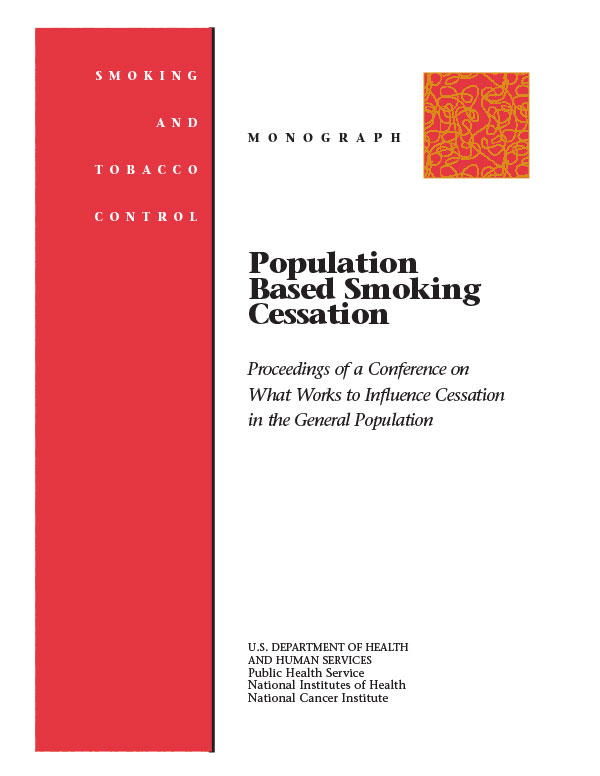
Provides research on the following efforts to reduce smoking in the general population: workplace smoking restrictions, physician intervention, self-help materials, quitlines, mass media, community-wide interventions, and population-based approaches. State-specific examples are discussed.
On This Page
The tobacco monographs can be ordered by sending an email to nci@gpo.gov. Please include the title and/or NCI Publication Number and the requested quantity.*
* Only the full report (Publication ID: M335) is available.
Suggested Citation
National Cancer Institute. Population Based Smoking Cessation. Tobacco Control Monograph No. 12. Bethesda, MD: U.S. Department of Health and Human Services, National Institutes of Health, National Cancer Institute. NIH Pub. No. 00-4892, November 2000.
View Individual Chapters
Chapters and key topics covered within each chapter are listed below. Chapters generally include an introductory section, details on methodology, a chapter summary, research needs, and a reference list.
- Acknowledgments (PDF, 62 KB)
- Contents (PDF, 35 KB)
- Chapter 1. Smoking Cessation: Recent Indicators of What's Working at a Population Level (PDF, 251 KB)
- Introduction and Overview
- What Works
- Chapter 2. Cessation and Cessation Measures among Adult Daily Smokers: National and State-Specific Data (PDF, 586 KB)
- Cessation
- Measures of Cessation
- Multivariate Logistic Modeling of Cessation Data
- Cessation in California
- Smoking Behavior in Massachusetts: 1993 to 1997
- Results
- Appendix 1 (Tables 2-7 through 2-20)
- Appendix 2
- Chapter 3. Restrictions on Smoking in the Workplace (PDF, 271 KB)
- Overview
- Changes in Smoking Behavior with Implementation of Smoking Restrictions
- Cessation
- Chapter 4. Population Impact of Clinician Efforts to Reduce Tobacco Use (PDF, 248 KB)
- Rationale for Clinician-Delivered Tobacco Interventions
- How Many Patients Receive Tobacco Advice and Assistance, and Do They Quit?
- Chapter 5. Impact of Medications on Smoking Cessation (PDF, 119 KB)
- Overview
- Use of Medications
- Efficacy/Effectiveness
- Interpretation
- Conclusion
- Chapter 6. Effect of Cost on Cessation (PDF, 204 KB)
- Background on the Role of Price/Taxation
- Overview of Recent Studies
- The Canadian Experience
- Effects of Cost on Measures of Cessation
- Long-Term Successful Cessation
- Measures of Cessation
- Caveats
- Appendix
- Chapter 7. Self-Help Materials (PDF, 142 KB)
- Utilization of Self-Help Materials
- Impact of Self-Help Materials on Smoking Cessation
- General Conclusions
- Chapter 8. Telephone Quitlines for Smoking Cessation (PDF, 145 KB)
- The Strengths of Telephone Quitlines
- The Use of Telephone Quitlines
- Efficacy of Telephone Quitlines
- An Area for Synergy: Telephone Quitline as a Support for Physician Advice and Adjuvant Treatment for NRT
- Conclusions
- Chapter 9 . Mass Media in Support of Smoking Cessation (PDF, 181 KB)
- California and Massachusetts Antismoking Advertising Campaigns
- Stanford Five-City Project
- Community Intervention Trial for Smoking Cessation (COMMIT)
- Discussion
- Chapter 10. Community-Wide Interventions for Tobacco Control (PDF, 60 KB)
- Are These Assumptions Correct?
- Do Community-Wide Interventions Work?
- What Lessons Have We Learned?
- Chapter 11. Interaction of Populations-Based Approaches to Tobacco Control (PDF, 138 KB)
- Overview
- Background
- Framework for Our Study
- Independent Evaluation Methods
- Sampling Schemes
- Data Collection Methods
- Approach
- Results

